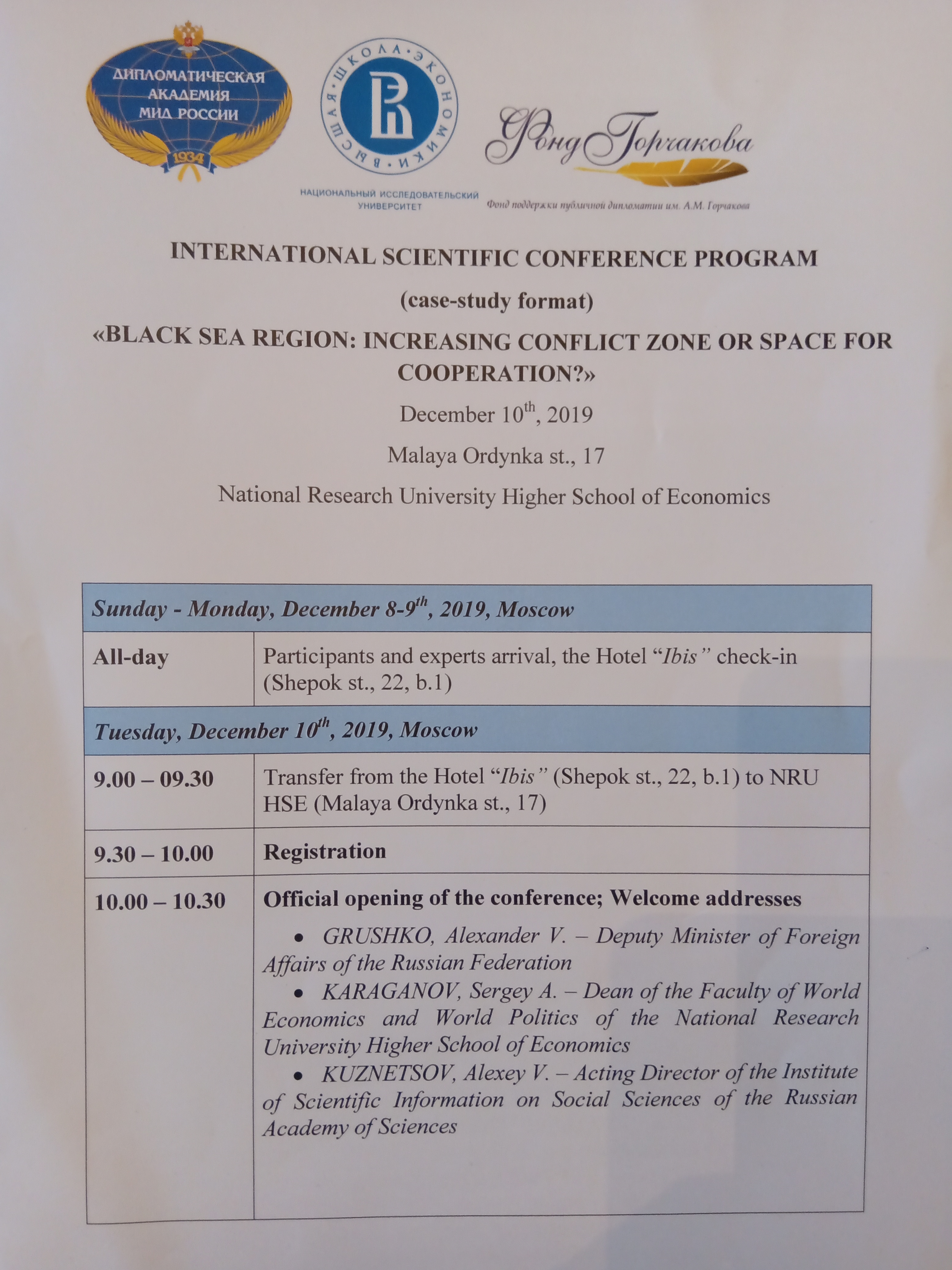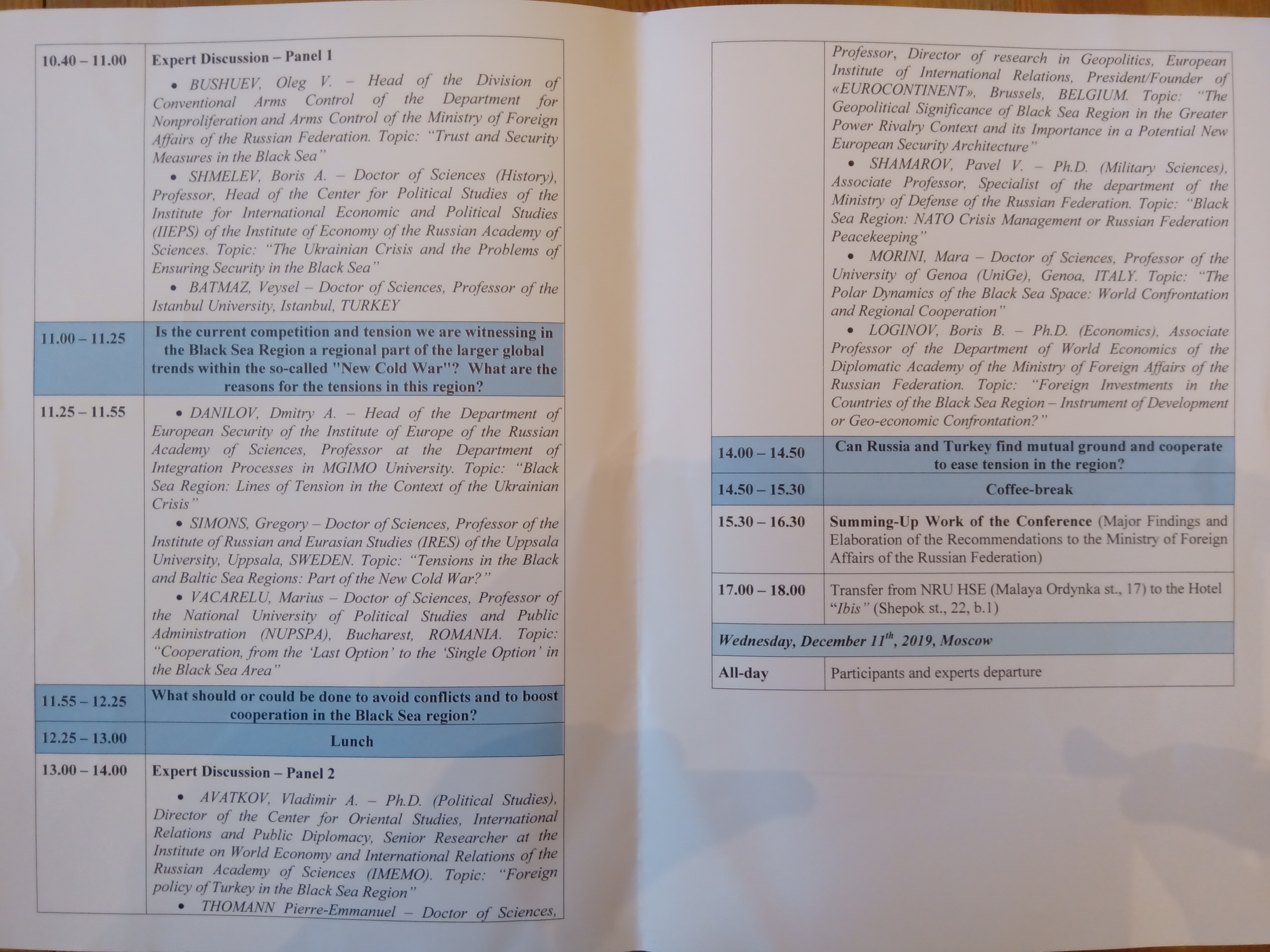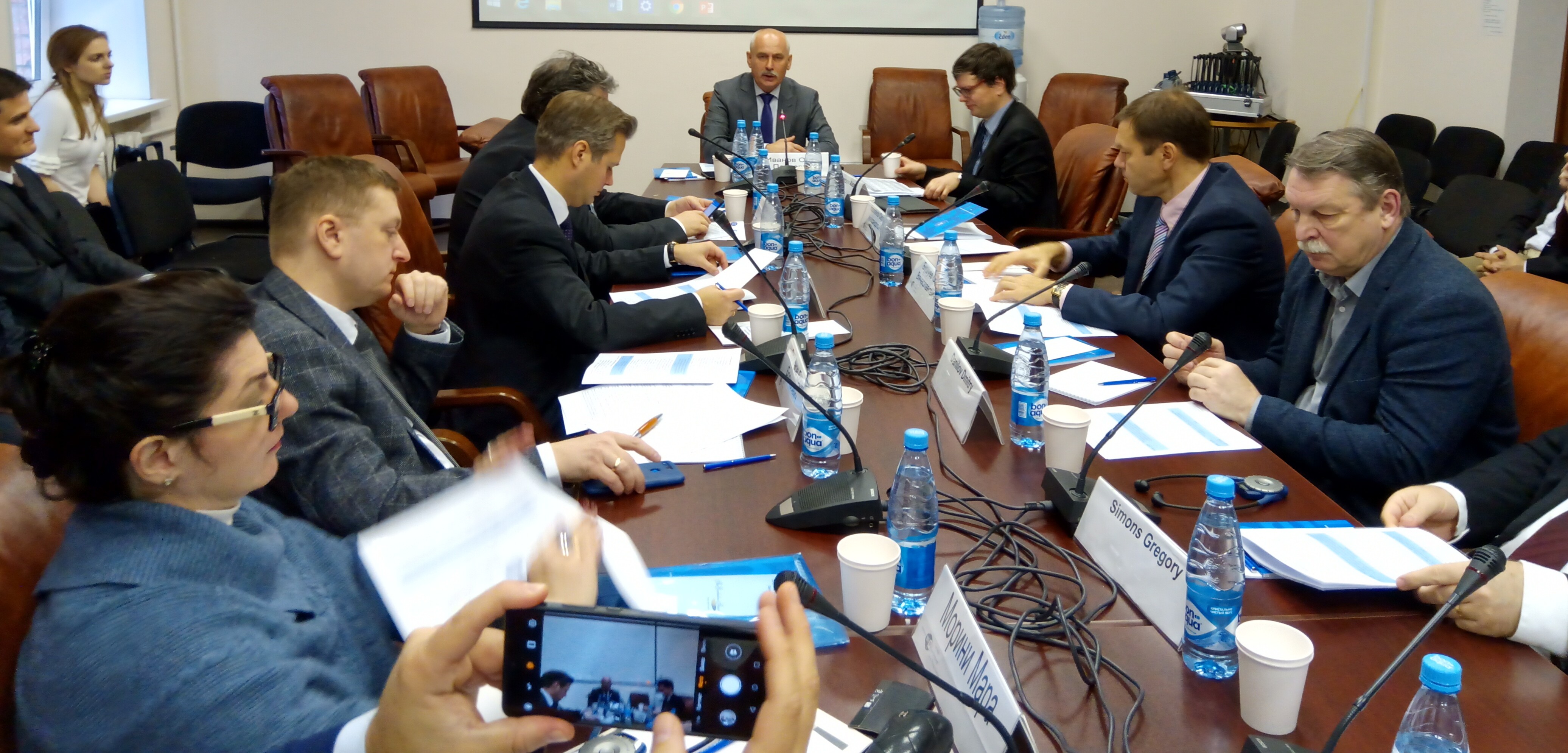
« The geopolitical significance of Black Sea Region in the Greater Power rivalry context and its importance in a potential new European Security Architecture »
Picture : Dr Oleg Ivanov – Chaiman of the conference- Vice -Rector of Reasearch – Diplomatic Academy of the Ministry of Foreign Affairs of the Russian Federation
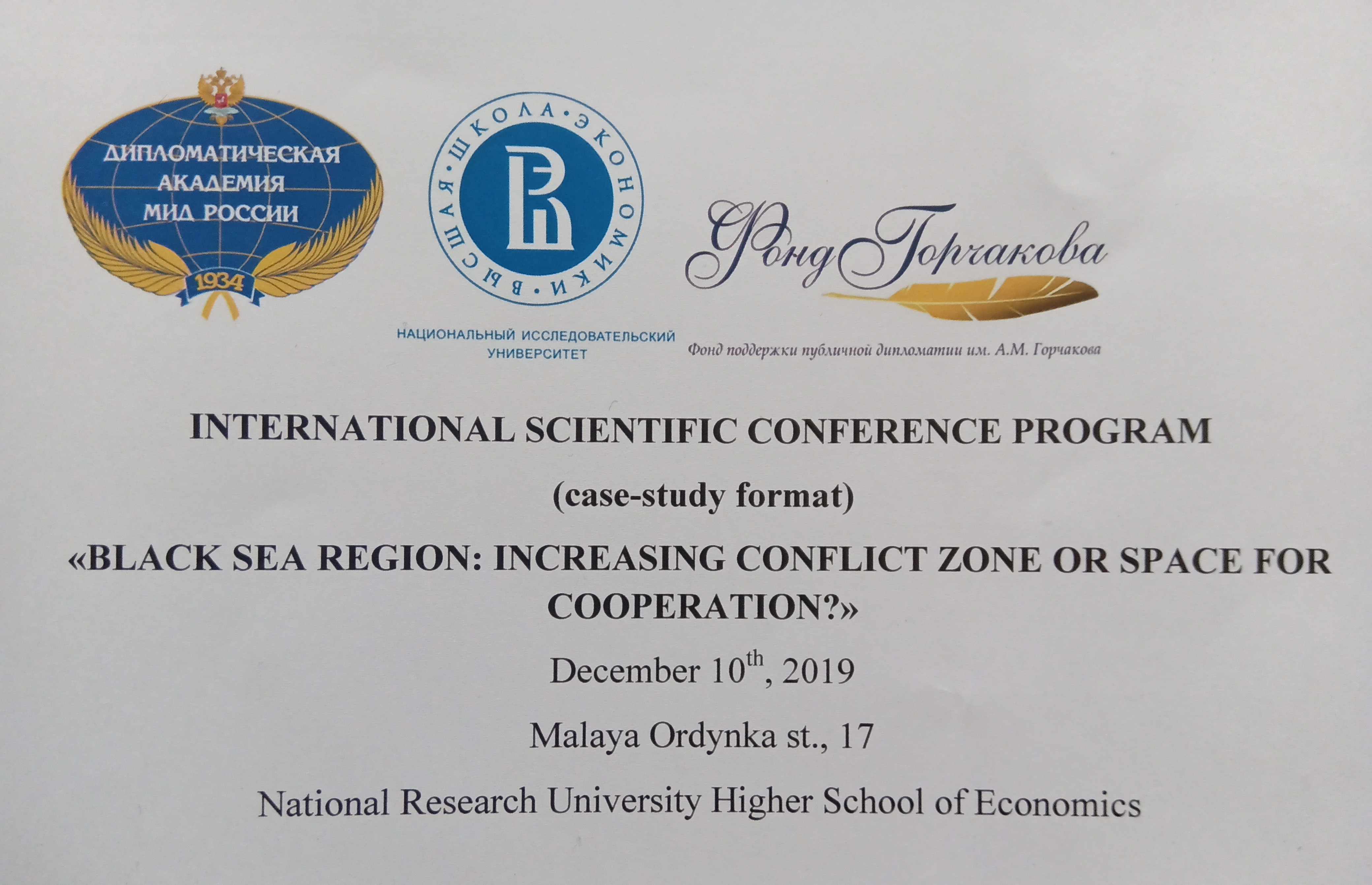
International Conference (Situation Analysis)
«The Black Sea region: An area of growing confrontation or a space for cooperation?»
Diplomatic Academy, Ministry of Foreign Affairs of the Russian Federation
National Research University “The Higher School of Economics”
Alexander Gorchakov Public Diplomacy Fund. December 10, 2019, Moscow, Russia
« The geopolitical significance of Black Sea Region in the Greater Power rivalry context
and its importance in a potential new European Security Architecture »
Contribution to the conference – Pierre-Emmanuel Thomann
Introduction
Crimea was the scene of a war that pitted Russia against a coalition of France, England, the Ottoman Empire and the Kingdom of Sardinia from 1853 to 1856. At the beginning of the 21st century, Crimea is again the subject of an international controversy, which now pits member states of the European Union and NATO against Russia. Crimea, a geopolitical pivot, is heir to a turbulent history and its highly strategic geographical position at the heart of the geopolitical configuration of Europe and the world, and therefore of the international order, yesterday as today. The actors are changing, but the geopolitical stakes remain.
Like yesterday after the Crimea war in 19th century, the crisis between the EU and Russia at the 21st century is likely to change the European and global geopolitical configuration, and therefore the international order. It is precisely for this reason that it is so difficult for states to overcome the current crisis.
Behind the Crimea and the Donbas issues, rival geopolitical visions and competing interests around the Black Sea are supported by governments of different states, today in 2019 as during the war in Crimea from 1853 to 1856. These different perceptions inherited from geography and history give rise to rival and different interpretations and perceptions.
What are these underlying geopolitical antagonisms ?
Two major developments characterize the geopolitical situation
that emerges in the 21st century:
-The world is fragmenting because globalization is a struggle for the distribution of geopolitical spaces simultaneously with the emergence of many actors.
– The ideological rivalries on the territory are more and more coming from the civilizational characteristics of the nations.
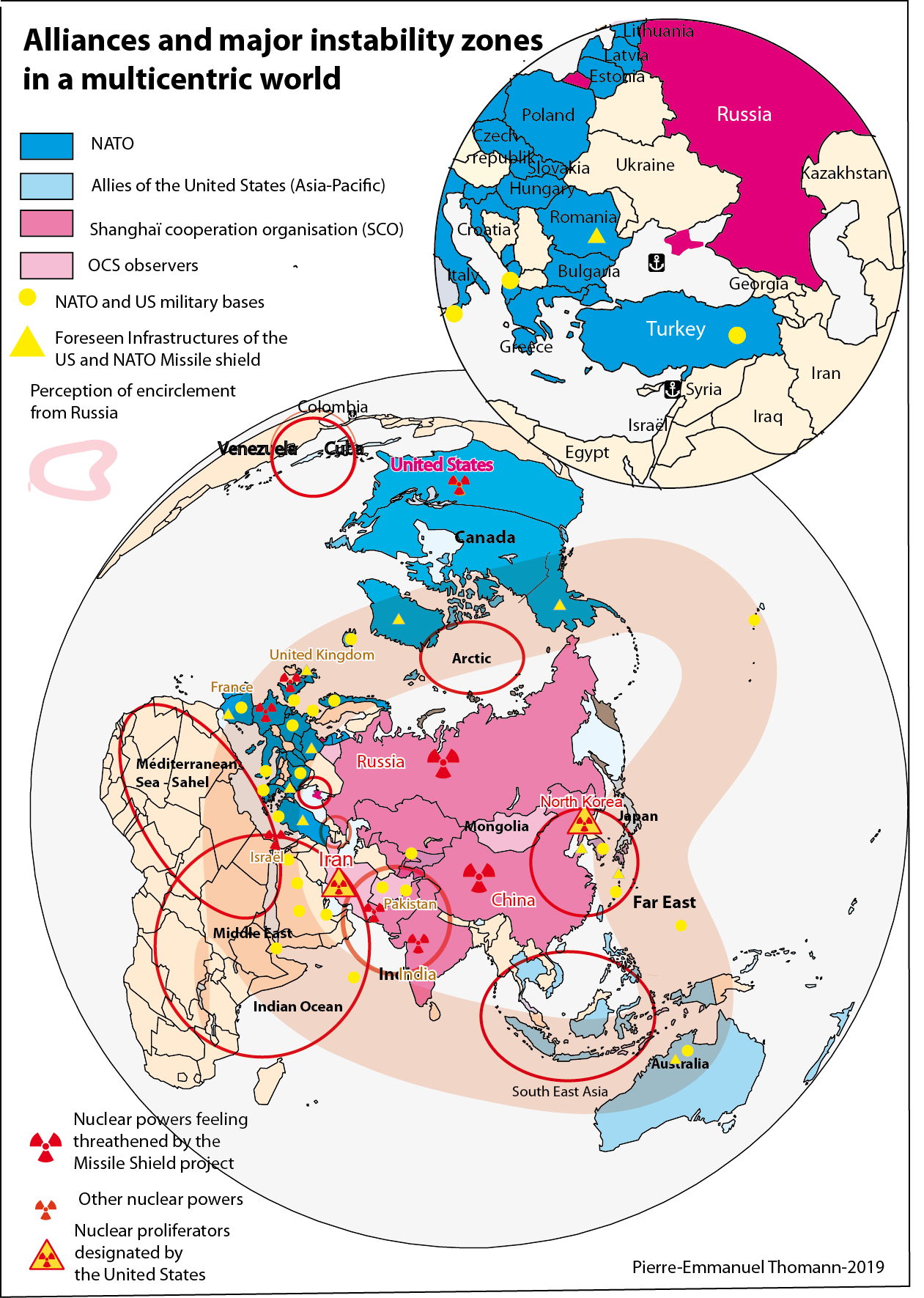
The encirclement of Eurasia by the United States
The United States see Europe as a Rimland, that is a coastal area under their control, which blocks an orientation of the European Union towards the Eurasian space, and therefore towards Russia, but also China through the Eurasian Continent. Europe is therefore only a theatre of the US foreign policy vis-à-vis Eurasia. Europe is only one of the two main theater of US foreign policy vis-à-vis Eurasia. This strategy consists of a encirclement of Eurasia by the Eastern European and Indo-Pacific fronts, and the positioning of NATO’s American bases, as well as the missile defense infrastructure (Map ). According to this encirclement maneuver of Eurasia, Ukraine and The NATO member states around the Black Sea are frontier-states employed to prevent the Black Sea from becoming a Russian lake. They are supposed to block the road to Russia to the world’s oceans in case of war. The idea in peacetime is to roll back Russia into its continental lands through successive NATO enlargement. This geopolitical strategy naturally causes in return a reaction from Russia.
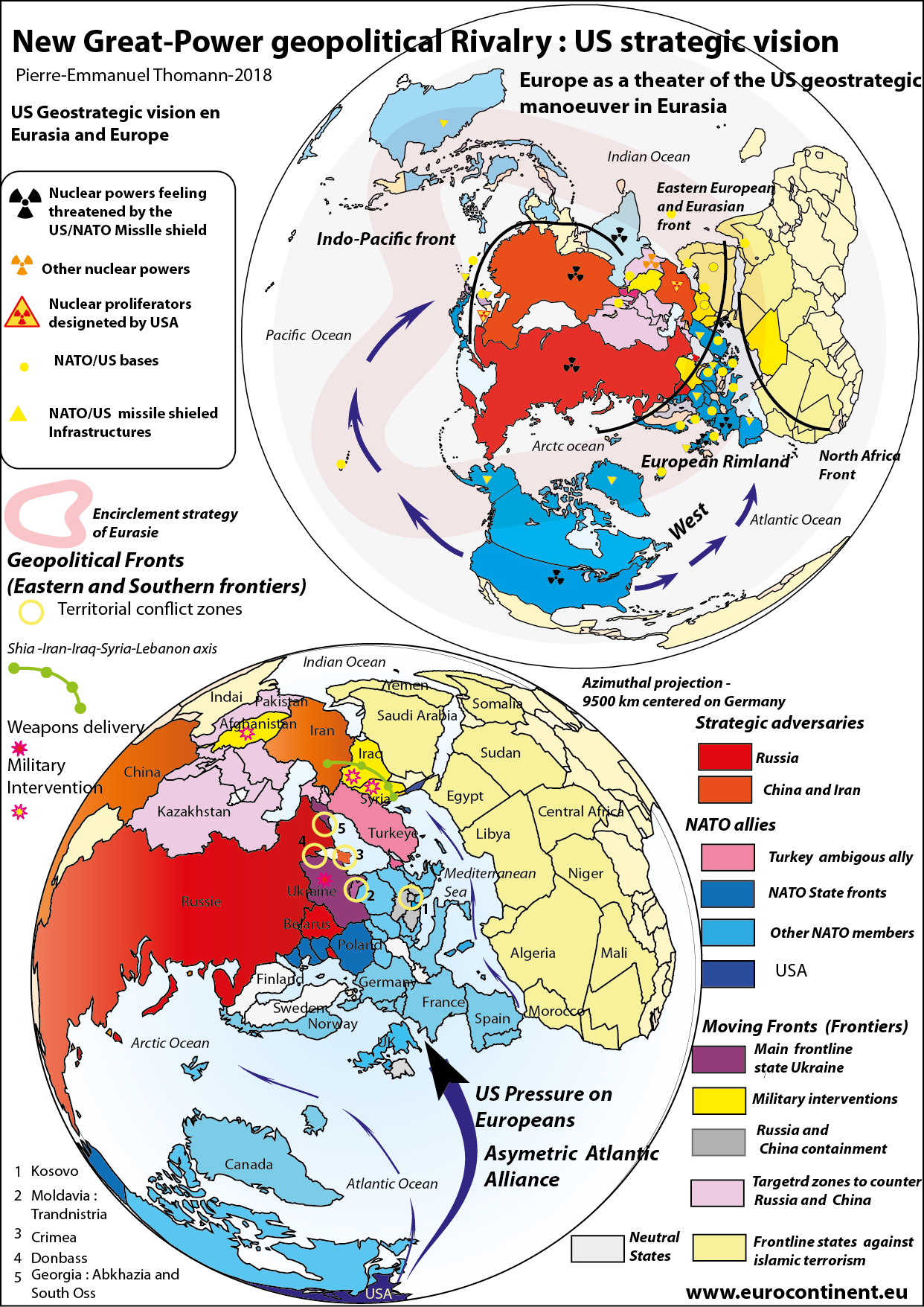
European Union without independent geopolitical positioning
What is the geopolitical positioning of the European Union behind this legal and normative stance ? Geopolitical priorities geopolitical vary from one Member State to another and are mostly implicit, since the normative ideology is more explicit.
However, a report from the European Parliament gives clues to understand its implicit position.
In this 2019 report , it is also stated that « whereas Russia’s polycentric vision of the concert of powers contradicts the EU’s belief in multilateralism and a rules-based international order; whereas Russia’s adherence to and support for the multilateral rules-based order would create the conditions for closer relations with the EU «
Despite the disagreement with American president Donald Trump on the question of multilateralism, the EU is therefore de facto in favour of a unipolar world that enshrines the primacy of the exclusive Euro-Atlantist vision under US leadership, since the polycentric vision contradicts the EU vision. The European Union considers herself as complementary to NATO and is therefore participating in the attempt to lock up Russia on the Eurasian continent and to reduce its room for manoeuvre in the Black Sea, with the promotion of the Eastern Partnership (Ukraine, Moldova, Georgia, Armenia, Azerbaijan).
The posture of Russia
Due to its geographical position, Russia is a central element of security in Europe, as well as throughout Eurasia. Its territory is contiguous with all major crisis zones in the world. Russia was implicated in the Georgia (2008), Ukraine (since 2014) and Syria (since 2015) conflicts because its territory is geographically contiguous with all areas of global tensions. Russia, like any state, seeks to protect its security and prosperity. Therefore it seeks to defend its security in its priority areas of interest.
At a global level, Russia is also actively involved in promoting a multipolar world in the context of globalization which is more and more becoming a conflict over allocation of geopolitical spaces. The aim is above all to challenge the unipolar Euro-Atlantist project under US leadership. Russia, on the opposite, seeks to promote a multicentered world so that it has a say in its priority areas of interest at regional level, in particular. It is not a question of recreating a power equivalent to the USSR, nor is it of restoring a bipolar world. Russia has neither the means nor the ambition for that. It is simply seeking a better geopolitical balance
Russia’s geopolitical priority objective was therefore to loosen its encirclement by the Atlantic Alliance. This objective is, at least temporarily, achieved. In the case of Georgia and Ukraine, their chances of joining the Atlantic Alliance are in the long term questionable. The frozen conflicts in Georgia, as well as the recognition of the independence of Abkhazia and North Ossetia by Russia, but also the independence of Transnistria in Moldova equally prevent an extension of NATO. According to Russia’s point of view, Crimea’s return to Russia is perceived as legitimate reunification. From the geostrategic point of view, it allows Russia to secure a privileged access to the Black Sea with total control of the port of Sebastopol. The Black Sea is the strategic access route for Russia to the Mediterranean, and therefore the warm seas. This port allows Russia to counter its encirclement by the NATO missile defense system (coupled with that of the United States) and NATO bases in the Black Sea.
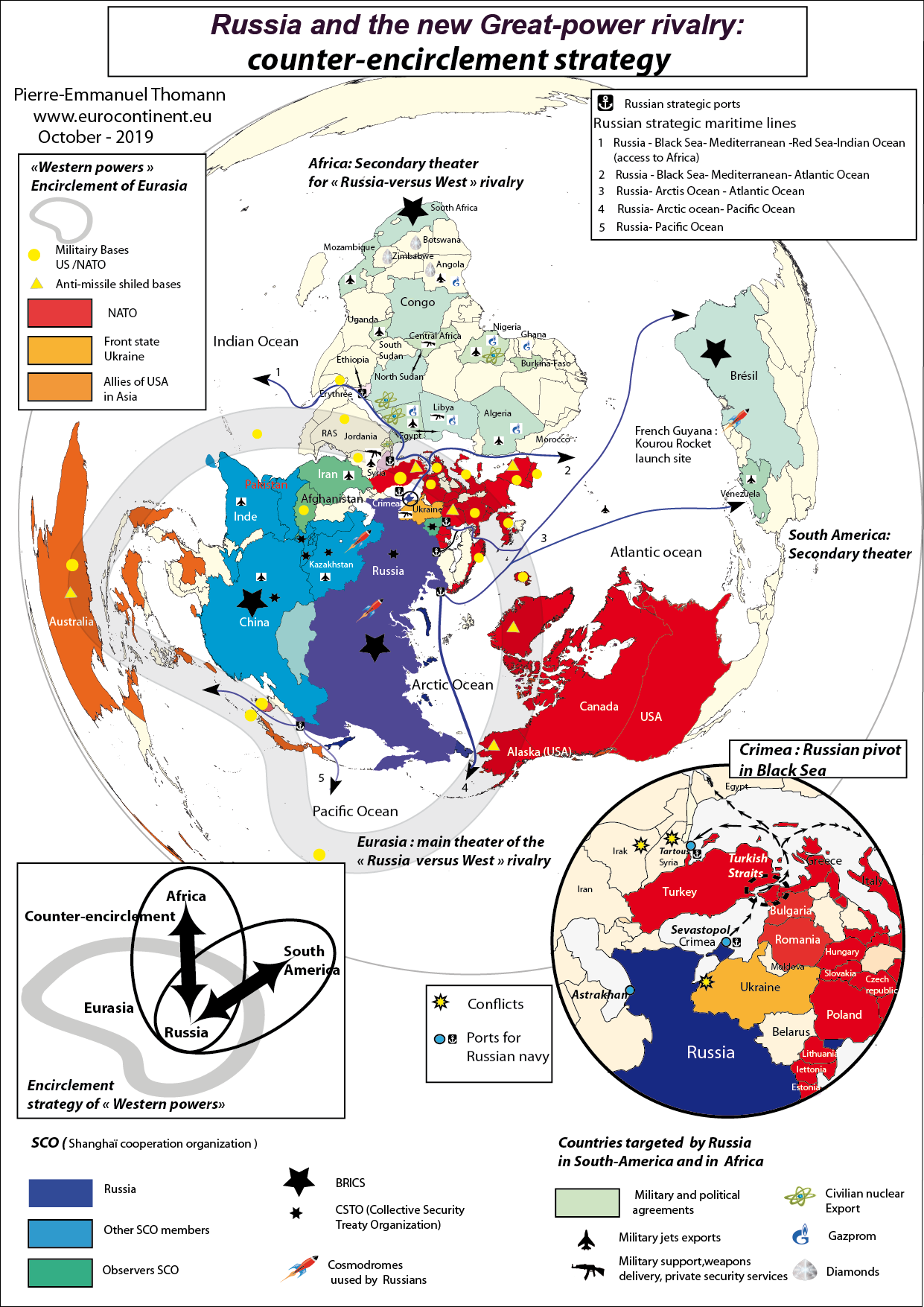
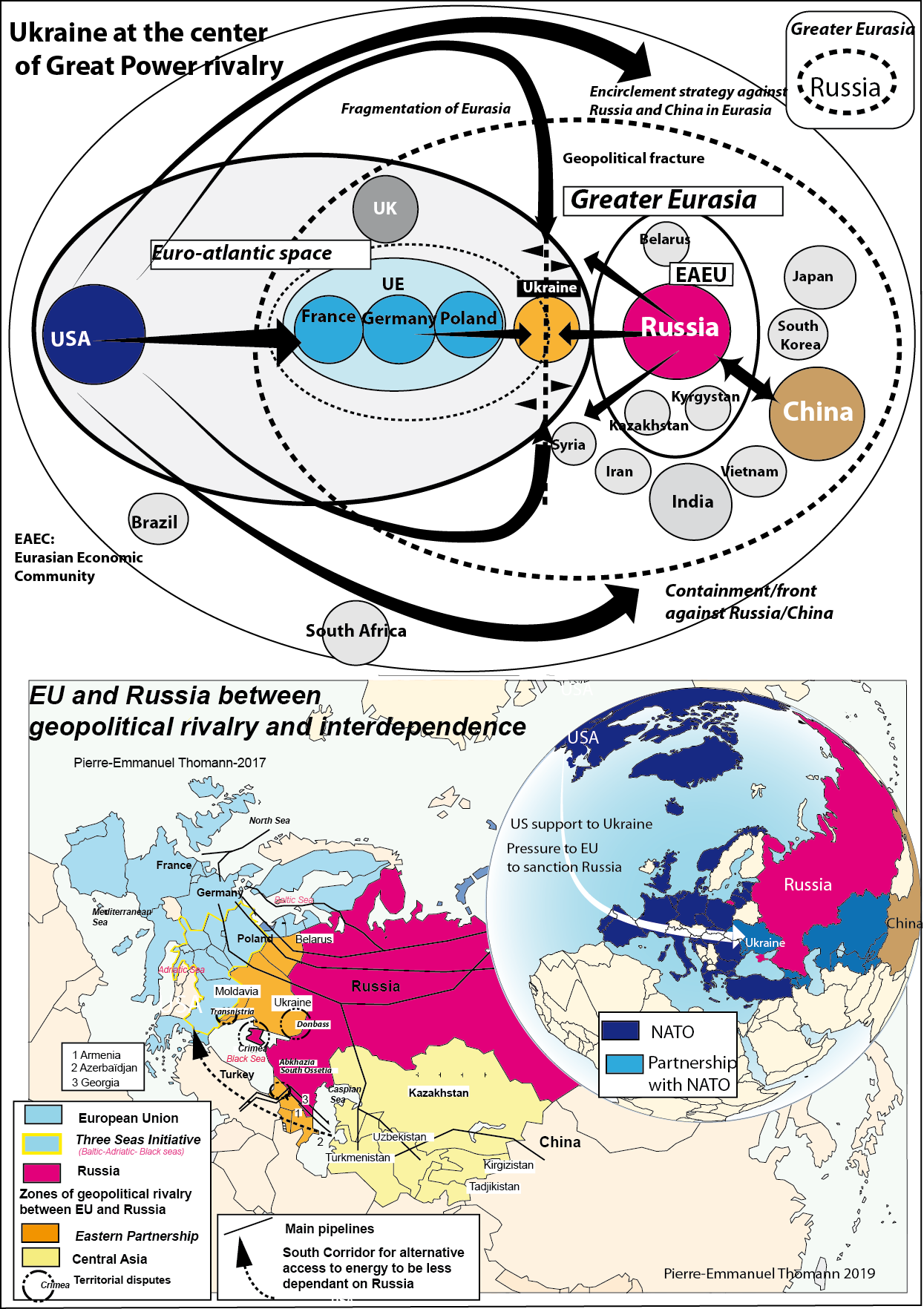
How to overcome the crisis?
Black Sea and Crimea, at the centre of a new European security architecture?
In the context of the emergence of polycentric geopolitical configuration, great power rivalry and the emergence of civilizational states, the European project can only reach geopolitical critical mass with Russia
More comprehensive negotiations at the continental level on the respective red lines are therefore more likely to change the context determined by rival geopolitical plans . Regional crises could be resolved in a more systemic arrangement.
The key to the future of the European project is Russia, and therefore the negotiation of a new European security architecture. However, the European Union has not yet adapted to the new geopolitical configuration, despite his recent aspiration for strategic autonomy.
The European Union is focusing on the principle of a « selective engagement » with Russia, hoping to negotiate separately between the various points of purchase between the EU and Russia. These include, in particular, frozen conflicts or » low intensity » conflicts resulting from the disappearance of the USSR, leaving behind border conflicts and Russian minorities in new neighbouring States: the question of Moldova and Transnistria, the Abkhazia and South Ossetia and Georgia, Nagorno-Karabakh and Azerbaijan, and the more acute question of Ukraine with the Donbas and Crimea at the centre of rival geopolitical visions.
It is, however, illusory to think that these different crises can be solved on an individual basis because they are all part of a larger systemic crisis opposing rival Western and Russian visions. Only an effort to develop a global and shared diagnosis and the negotiation of a new European and pan – Eurasian geopolitical architecture will pave the way for a resolution of the different local and regional crises. This could be extremely difficult in the current situation, but it is the only solution if Russia and the EU want to avoid a situation of permanent crisis and increasing rivalry. Two processes could be conducted in parallel, one bottom-up, and the other top- down.
The principle of « selective engagement » of the EU can be a useful instrument in the negotiation as a measure of confidence and security, but cannot solve the global geopolitical situation at the origin of the crisis. This requires a reform of the EU so that Europeans identify their own geopolitical interests with Russia, according to their own geography. Both processes, the resolution of the Ukrainian question to stabilize the situation, and the promotion of a new European Security architecture to avoid a lasting divide and restore more unity in Europe should reinforce each other.
The question of Ukraine and especially Crimea is the most central issue, but obviously the most sensitive. If the Minsk process focuses on the Donbas, the fact remains that in a more implicit way, Crimea remains the most serious difference. If the Donbas crisis were satisfactorily contained or solved, the question of the return of Crimea to Russia remains a thorny issue. In the current context, the EU and the United States do not want to recognize the ownership of Crimea in Russia. However, Crimea will remain Russian, especially since it has always been in history.
This is all the more difficult to accept for Westerners, as Crimea, geopolitical pivot of Russia in the Black Sea, towards the Mediterranean and the oceans, and towards the Middle East, is the object of a rivalry with the Western powers over long periods of history, especially during the Crimean War of 1852-56, during the Cold War and until today. This is why a new European security architecture is the key to solving local and regional crises and not the reverse, from local to regional. A new European security treaty at the Eurasian level is the missing link in European security in the context of the emergence of a multipolar world and facing the risk of a widening gap between Euro-Atlantic alliances and emerging alliances in Eurasia (see figure). It is in this great context that the Ukrainian question, Crimea and Donbas could find a favourable outcome. A progress in the negotiations for a New European security architecture, a combination of bilateral relations, consultations between national governments and international organizations, trade and energy relations and exchanges of civil society, would be needed.
The three levels are
– the sphere of states and nations, according to a model inspired by the concert of nations on the principle of geopolitical balance, therefore the multipolar model
– the level of international organizations, such as the EU NATO, the OSCE, the Council of Europe, the SCO, the UN, UNESCO, which negotiate common actions, thus the multilateralist model.
– the level of trade and energy
– the level of civil society, with academic and think-tank experts exchanges, religious contacts
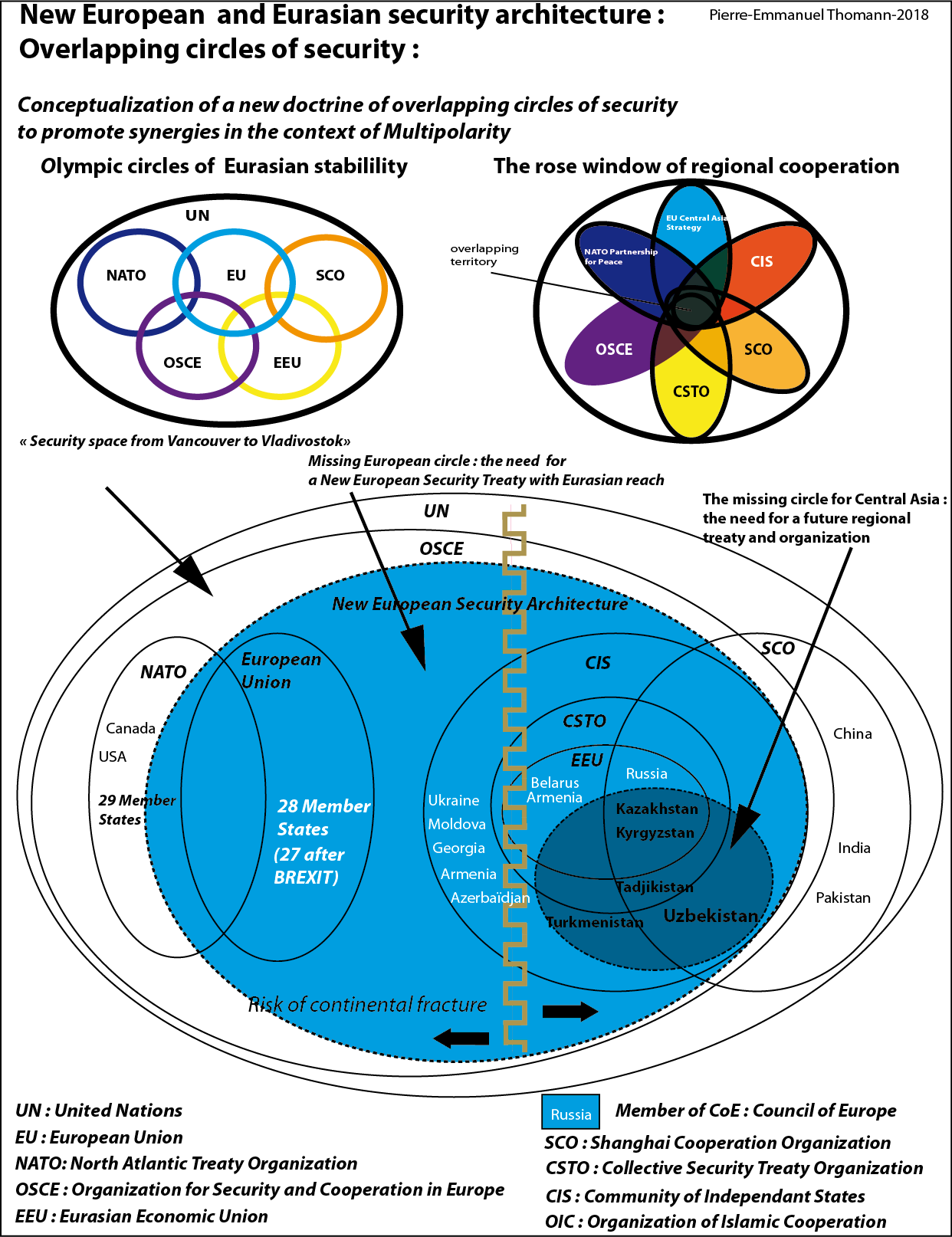
Security focus on the arc of crisis South
The EU and Russia must also overcome the Ukrainian crisis in order to focus on Islamist terrorism as a priority threat. The successful implementation of the Minsk II agreements requires further pressure on the Ukrainian government as they block the process of federalization. Ukraine should adopt the status of neutrality and act as a bridge of cooperation instead of acting as a front line between « the West » and against Russia (no NATO or EU); (Map 7, « The European Union squeezed between two arcs of crisis »).
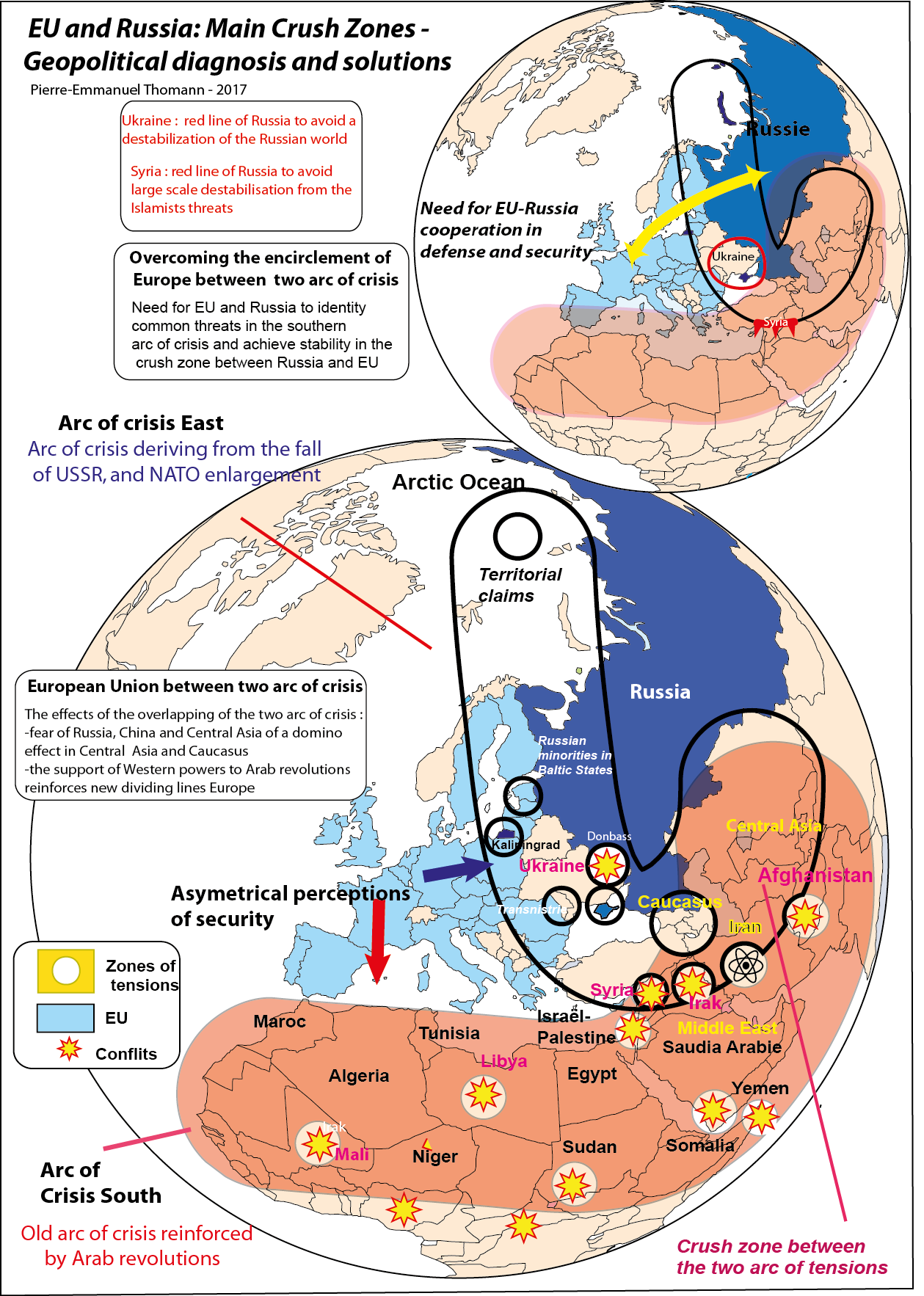
Conclusion
The long term purposes of the European project cannot be imagined without Russia.
This reality seems to be taken into account from French governments The necessity stressed by the French President Emmanuel Macron of a New European Security Architecture with Russia, was again mentioned in August 2019 . A similar proposal was previously proposed by Russian President Dimitri Medvedev in the aftermath of the Russia-Georgia war in 2008. The German government’s coalition treaty, for its part, mentioned a « Europe from Lisbon to Vladivostok » as an economic objective.
The conditions imposed by the German and French governments to move forward, the strategic autonomy of the European Union’s in the area of defence and security and the implementation of the Minsk agreements by Russia, are unrealistic. They therefore constitute obstacles as long as Ukraine does not implement the federalization of the country. The recent revival of the Normandy format (Germany, Russia, Ukraine and France) to implement Minsk agreements will indicate if any fundamental improvement is possible. But it must be remembered that it concerns only the Donbas, not Crimea. The strategic autonomy of the EU is an illusion. The processes must proceed in parallel and could also be separated to avoid obstacles. The question of values, in particular the idea of a superiority of liberal democracy according to the norms of governance of the EU, each time emphasized by the French presidents and the German Chancellor, are also ideological obstacles. Geopolitical equilibrium issues should be considered first.
The biggest challenge of the European project is to agree to find a place for Russia and that Russia agrees to position itself in a reformed European project. « Greater Eurasia » and « Greater Europe » could be combined to counterbalance the most powerful geopolitical projects on both sides of Eurasia, the Greater West based on « American First », and Greater Asia with the Silk road Chinese project. This would prevent the EU and Russia from being the junior partners of these rival geopolitical projects. The EU being a sub-element of the Great West and Russia a sub-element of » Greater Asia » .
The political context still makes it very difficult to implement these ideas. However, in the long run, after a decade of fruitless confrontation, European states and the United States could realize that their own geopolitical vision is obsolete and finally accept the establishment of a new global concert of powers in the emerging multipolar world. On the longer term perspective, it is the notion of the « West » that should be questioned, so that civilizational Europe, from Lisbon to Vladivostok, can find its roots on the basis of Latin Christianity (Catholic and Protestant) but also Greek (Orthodox) .
Crimea as a geopolitical pivot, yesterday as today
In the end, Crimea, and therefore geopolitical rivalries in the Black Sea are again at the centre of the controversies over the international order, in 1855 as in 2019. The geopolitical configuration has changed, but not the geography, nor the rivalry between powers on the regional, pan-European and regional and world scales. Geopolitical issues over long times have striking similarities since geography does not change.
Crimea remained the geopolitical pivot in 1858, as in 2019, which allowed Russia to position itself as a major power at the Eurasian and world level and the other major European powers, the United Kingdom, Germany and France, sought to contain the return of Russia to the European and world balances.
At the end of the Crimean War from 1853 to 1856, France was determined to regain a central position in the geopolitical configuration of the mid-nineteenth century after opposing Russia. France had lost that place after the stop given by the Holy Alliance to Napoleon’s expansionism
Today, it is rather a new substantial reset between France and Russia that would pave the way for a European and global balance more favourable to France since the geopolitical centre of gravity of the European project is occupied by Germany as a European Central power and the United States with NATO. Russia is also seeking to guarantee its security on its western flank long after invasion Napoleon I Napoleon III, and finally Hitler, and NATO expansionism after the disappearance of the USSR.
The idea of a European security architecture cannot be brought into the first place by the 27 or 28 EU Member States, since the differences are too great. The recent debates at the NATO summit after the comment of the French President that NATO was « brain dead » has demonstrated that NATO members states are deeply divided. If NATO is “brain dead”, EU is “brain dead” as well since divisions within EU are as strong as in NATO. However, the pursuit of the idea of a New European Security architecture promoted bilaterally is intended to show the stalemate of the exclusive Euro-Atlantist vision. In a second step, the negotiation of a Franco-German-Russian axis, which had been anticipated during the war in Iraq, could once again be at the heart of the European and global geopolitical equilibrium. A combination of confidence building measures under the EU selective engagement principle, and a more larger negotiation on a new geopolitical order could be engaged in a parallel way. The broader agenda need to include the respective red lines, the freeze of EU and NATO enlargement, the neutralization of Ukraine.
The need for a new European security architecture as a necessary framework for resolving geopolitical disputes between the EU and Russia, including the Crimea issue. Meanwhile, according to the most likely scenario of evolution of the crisis, since the lifting of the sanctions is very uncertain in the near future, it is the creativity and the attempt to circumvent the sanctions to make them more and more useless which would be the most accessible way. When governments realize that these sanctions are not only politically useless but less and less applicable on the ground or counter-productive, the lifting of sanctions may be considered.
The question of recognition of Crimea as an integral part of Russia is an even more difficult issue, but it will depend on the political will not to make it an obstacle to cooperation. The case of Turkey and the non-recognition by the EU of the Turkish Republic of Northern Cyprus, which is de facto under Turkish military control, demonstrates that this does not constitute an obstacle, nor for a customs union between the EU and Turkey, neither for financial support for Turkey (migration crisis and pre-accession funds), nor to continue EU accession negotiations.However, it must be emphasized that this rapprochement can only be achieved on a principle of equality and a geopolitical balance between Russia and Western Europeans states, and not on the principle of an extension of the normative doctrine of the EU. The EU, whose normative and ideological principles are not anymore adapted to the new global and European geopolitical configuration should also be subject to a fundamental reform process. If this proves impossible, bilateral relations with Russia should be the driving force behind a new settlement. The doctrine of multilateralism put forward by the EU cannot be developed without a prior and accepted multipolarity.
The sanctions against Russia and Crimea in particular are a failure because the situation has not changed. The EU and Russia are in a situation of deadlock to the detriment of everyone.
Crimea was in the past and will in the future part of Russian. This is the intractable reality not only from the historical point of view but also from geopolitical realism.
The cooperation themes concerning Crimea and Black Sea could be:
-the ports of the Mediterranean and Black Sea (Sevastopol) as military projection platforms for the stabilization of the crisis arc in southern Eurasia, especially to the Middle East and the Mediterranean to fight against terrorism
-common posture in the face of the risk of a new armaments race, particularly with medium-range missiles (which would have an impact on Crimea, an essential territory for the military infrastructures of ANTI-Access/ Area- Denial (A2/AD)
– synergy and cooperation between the Mediterranean ports and the port of Sevastopol in relation to the project of the Three Seas Initiative (Baltic-Adriatic-Black Sea)
-synergy and cooperation between the Mediterranean ports and the port of Sevastopol in terms of trade, but also a positioning vis-à-vis the Chinese project Silk Road
-cooperation on the Mediterranean-Black Sea energy routes
-exchanges of the civil society, universities, tourism, because the European unity will depend on the rapprochement between the States but of the peoples
It is for this reason that the idea of a new European architecture gives a particular responsibility to France but also Russia, two balancing powers before hopefully leading other European states. It is still necessary to remove the obstacles, and that passes by the acceptance of the return of the Crimea to Russia. Overcoming the different geopolitical controversies in Europe between Russia and the EU member states, and in particular Crimea, will be a central step before promoting a Europe from the Atlantic to the Pacific, as is was anticipated by General de Gaulle. The European project will only reach a critical geopolitical mass in the emerging multicenter world with Russia.
Outlook: scenarios based on geopolitical hypotheses
-The crisis between Russia and the EU is structural, and therefore can only be solved by a modification in the geopolitical configuration : a reform of the European project in the direction of greater independence vis-à-vis the United States. This is a very long-term scenario, assuming it is feasible.-A change in geopolitical posture of the United States is also a possibility, with a rapprochement with Russia to contain China, but Russia will probably play the balance between the United States and China , so the scenario is very uncertain-A very serious international conflict that affects the interests of the EU Member States and Russia might lead t more cooperation between governments and come closer (in the Middle East for example) but the risk of an increase of the fracture also exists.
Main trend scenario
– The most likely scenario is the transformation of the Donbas conflict into a frozen conflict, with the end of fighting. However , the federalization of Ukraine and the full control of the borders by Ukraine, might be extremely difficult to reach. As long as the risk of enlargement of Ukraine to NATO is a possibility, even implicit, and there is no perspective of neutralization of Ukraine (No NATO, nor EU), the complete resolution of the crisis is unlikely
– In the best case, if the conflict in Donbas is resolved, the question of Crimea remains. Sanctions are likely to remain active in the long run: the central issue is to make them more and more inactive: this involves getting around sanctions by the actors in a bottom-up way, until policies and governments realize that sanctions are in fact no longer applied. A creative approach to the circumvention of sanctions is therefore the main issue in the medium term.- The EU is divided and its multiple internal crises lead to the inhibition of any decision that might be seen as a setback for EU on Ukraine. sanctions have the role of masking disunity, and making Russia the scapegoat for EU problems. The central question is a face-saving mechanism for both parties after being locked in a confrontation and sanctions without outcome and results that benefit rival external powers.
-The exit strategy of the crisis is also an integral part of the Franco-German, geopolitical rivalry.-However we will not return to the ex-ante situation. The EU ( new memorandum of Markus Ederer, EU ambassador, https://www.ft.com/content/725aa5b6-d5f7-11e9-8367-807ebd53ab77 ) proposes technical cooperation on thematic issues; Arctic, Digital, the Eurasian Economic Union, regional infrastructures, the « Nordic dimension » between the EU, Russia, Norway and Iceland. The idea behind this idea is to balance the emergence of China, but it cannot change the geopolitical configuration, and solve the fundamental security issues that require a New European Security Architecture- Russia undertakes a sustainable policy of import substitution with its own productions according to an understanding of sovereignty that goes against the ideology of European integration paradigm, and this makes negotiations difficult, especially since EU member states disagree also on this question.- Russia will be ready for concessions, when its alliances with Asian countries will give it more weight to negotiate with EU member states and the United States. The Greater Eurasia project is supposed to facilitate this approach, but EU did not yet respond to this new idea.- Inspiration from Japanese model or Turkish model: there is an irremediable dispute as the non-recognition of new borders but the cooperation continues (the Turkish case: accession negotiations and common market). It’s really about political will- the idea of visa facilitation is a good idea
Extreme negative scenario
– Negative extreme scenario: the strengthening of the crisis. A weak Ukraine needs an ongoing crisis to have the support of the EU and USA, and reinforces the divide with Russia and thus also between the EU and Russia-If the conflicts gets worse, and sanctions as well, or the outbreak of a greater external crisis, in the end the question could solved but by with the defeat of Russia or EU as zero sum game. This an unlikely scenario.
Extreme positive scenario
– Extreme scenario, positive: the combination of an implementation of the new European Security Architecture and the bottom-up cooperation of businesses , actors of civil society, restores confidence and sanctions are gradually lifted. However this scenario is unlikely in the short and medium term because for now the New European Security Architecture involves concessions considered unacceptable on the part of Russia, The EU is too weak to make concessions, and Russia is so far the scapegoat of EU internal crisis, with the pressure from the United States and its closest allies is too strong-The possibility that an EU member state is blocking sanctions is uncertain. This can not happen before the very uncertain French or German elections, or the renewal of Trump
Annexes : Policy recommendations
1) Is the current competition and tension we are witnessing in the Black Sea Region part of the global trends within the so–called “New Cold War”? And what are the reasons of the tensions in the region?
At the beginning of the 21st century, Crimea is again the subject of an international controversy, which now pits member states of the European Union and NATO against Russia. Crimea, a geopolitical pivot, is heir to a turbulent history and its highly strategic geographical position at the heart of the geopolitical configuration of Europe and the world, and therefore of the international order, yesterday as today. The actors are changing, but the geopolitical stakes remain.
Like yesterday after the Crimea war in 19th century, the crisis between the EU and Russia at the 21st century is likely to change the European and global geopolitical configuration, and therefore the international order. It is precisely for this reason that it is so difficult for states to overcome the current crisis.
Behind the Crimea and the Donbas issues, rival geopolitical visions and competing interests around the Black Sea are supported by governments of different states, today in 2019 as during the war in Crimea from 1853 to 1856. These different perceptions inherited from geography and history give rise to rival and different interpretations and perceptions.
What are these underlying geopolitical antagonisms ?
Two major developments characterize the geopolitical situation
that emerges in the 21st century:
-The world is fragmenting because globalization is a struggle for the distribution of geopolitical spaces simultaneously with the emergence of many actors.
– The ideological rivalries on the territory are more and more coming from the civilizational characteristics of the nations.
The United States see Europe as a Rimland, that is a coastal area under their control, which blocks an orientation of the European Union towards the Eurasian space, and therefore towards Russia, but also China through the Eurasian Continent. Europe is therefore only a theatre of the US foreign policy vis-à-vis Eurasia. Europe is only one of the two main theater of US foreign policy vis-à-vis Eurasia. This strategy consists of a encirclement of Eurasia by the Eastern European and Indo-Pacific fronts, and the positioning of NATO’s American bases, as well as the missile defense infrastructure. According to this encirclement maneuver of Eurasia, Ukraine and the NATO member states around the Black Sea are frontier-states employed to prevent the Black Sea from becoming a Russian lake. They are supposed to block the road to Russia to the world’s oceans in case of war. The idea in peacetime is to roll back Russia into its continental lands through successive NATO enlargement. This geopolitical strategy naturally causes in return a reaction from Russia , and is damaging long stability around the Black Sea.
Despite the disagreement with American president Donald Trump on the question of multilateralism, the EU is till now therefore de facto in favour of a unipolar world that enshrines the primacy of the exclusive Euro-Atlantist vision under US leadership, since the polycentric Russia vision contradicts the EU vision. The European Union considers herself as complementary to NATO and is therefore participating in the attempt to lock up Russia on the Eurasian continent and to reduce its room for manoeuvre in the Black Sea, with the promotion of the Eastern Partnership (Ukraine, Moldova, Georgia, Armenia, Azerbaijan).
Then, to improve cooperation in Black Sea region, EU has to fundamentally reform itself and build its own geopolitical vision to move away from the exclusive atlantist vision. It should take advantage of multipolarity and its geographical position in order not to be cut from cooperation on its eastern flank, especially on Black Sea region.
2) What should and or could be done to avoid conflicts and to boost cooperation in the Black Sea region ?
-The importance of geopolitical linkages
Stability and cooperation in the Black Sea region, is depending on the longer term on the systemic change of the geopolitical order both at global, and pan –Eurasian level.
As a reaction to the encirclement strategy of Eurasian continent by the US and its Atlantist allies, Russia is building a counter-encirclement strategy (Greater Eurasia project, cooperation with Africa, South America…). As long as the EU position itself mainly as a sub-circle of Euro-Atlantic vision, and sees itself as complementary to NATO, no long term trust can be gained with Russia. The scenario of a unipolar world will reduce cooperation, raise geopolitical fragmentation and degrade security in the Black Sea. To improve stability in the Black Sea, the acceleration of the emergence of the global multipolarity is necessary to maintain balance between great powers and avoid the domination of Black Sea by NATO. Russia might find bilateral partners to accelerate multipolarity with Turkey, France (as part of the new reset), in order to balance the more pro-NATO states around the Black Sea. Acceleration of multipolarity is multiplying linkages opportunities for negotiations (negotiations of respective red lines in different theatres like Eurasia, Africa, Black sea…between great powers).
The improvement of the situation in Black Sea is depending both at improvements at a larger level between US and Russia at global level, EU and Russia at pan-European and Eurasian levels, and improvements between Black Sea states for the regional level. A combination of confidence building measures under the EU selective engagement principle and a more larger negotiation on a new geopolitical order could be engaged in a parallel way. The broader agenda need to include the respective red lines, the freeze of EU and NATO enlargement, the neutralization of Ukraine. EU should stress that Eastern Partnership policy would never pave the way to a future EU enlargement, since today ambiguity reduces trust between EU and Russia regarding Ukraine, Moldova and Caucasus states (again bilateral ties might be there useful between France and Russia, as France is suspicious of more EU enlargement).
Bilateral relations are also crucial. Today, a new substantial reset between France and Russia, if implemented, might pave the way for a better European and global balance more favourable to France and Russia since the geopolitical centre of gravity of the European project is occupied by Germany as a European Central power and the United States with NATO. This would indirectly improve the situation in the Black Sea.
-To improve cooperation in the Black Sea region, a two track and complementary approach might be appropriate with the top-down process between states (Politicians and diplomats and a bottom up approach between civil societies (academic and experts circles, culture, business …).
Top down
Confidence building measures negotiated from different states around Black sea are important to improve trust, and pave the way in the longer term longer term to a new European and Eurasian security architecture. The thematics are security, terrorism, militarization of Black Sea, medium range missiles (since the collapse of INF treaty), NATO anti ballistic missile system, NATO enlargement freeze…
–Balancing Northern dimension with Southern dimension: The EU (new memorandum of Markus Ederer, EU ambassador, https://www.ft.com/content/725aa5b6-d5f7-11e9-8367-807ebd53ab77) proposed technical cooperation on thematic issues; Arctic, Digital, the Eurasian Economic Union, regional infrastructures, the « Nordic dimension » between the EU, Russia, Norway and Iceland. Russia could suggest to apply the same framework on the southern dimension , since cooperation is even more needed around Black Sea states? A balance is also needed between the northern and southern dimension.
–Circumventing the sanctions: Since the lifting of the sanctions is very uncertain in the near future, it is the creativity and the attempt to circumvent the sanctions to make them more and more useless which would be the most accessible way. When governments realize that these sanctions are not only politically useless but less and less applicable on the ground or counter-productive, the lifting of sanctions may be considered. To move towards this direction, bilateral negotiations (France and Russia, German and Russia, Italy and Russia..) for circumventing of sanctions, including specific sanctions on Crimea, might be the best way to avoid direct pressure from US on EU and the fear of too visible EU disagreements Sanctions against Russia are also a tool for fostering EU unity in times of EU multiple crisis, and this also why it is difficult to lift sanctions as EU does not want to be seen as weak….).
Bottom up
It is important researchers, experts and academics focus more on common interests thematic to balance the more polemic relations between Politicians and Diplomats of the different states.
-It is very important to promote academic, experts and students exchanges between universities, think tanks and higher education institutes between Black Sea adjacent countries, but also between EU member states, Russia and Turkey, to facilitate mutual understanding and cooperation on security in the region. Both governmental and civil society exchanges and cooperation project on the elaboration of a common diagnosis, identification of common interests and also long term common geopolitical vision would help to contain political misunderstanding and geopolitical fractures. The comprehension and identification of respective and divergent geopolitical representations and perceptions is very important to identify obstacles to cooperation. Since
The cooperation themes concerning Crimea and Black Sea between EU member states and Russia could be:
-the ports of the Mediterranean and Black Sea (Sevastopol) as military projection platforms for the stabilization of the crisis arc in southern Eurasia, especially to the Middle East and the Mediterranean to fight against terrorism
-common posture in the face of the risk of a new armaments race, particularly with medium-range missiles (which would have an impact on Crimea, an essential territory for the military infrastructures of ANTI-Access/ Area- Denial (A2/AD)
– synergy and cooperation between the Mediterranean ports and the port of Sevastopol in relation to the project of the Three Seas Initiative (Baltic-Adriatic-Black Sea)
-synergy and cooperation between the Mediterranean ports and the port of Sevastopol in terms of trade, but also a positioning vis-à-vis the Chinese project Silk Road
-cooperation on the Mediterranean-Black Sea energy routes
-exchanges of the civil society, universities, tourism, because the European unity will depend on the rapprochement between the States but of the peoples
3) Can Russia and Turkey find Mutual ground and to ease tensions in the regions?
-Strict implementation of the Montreux treaty to limit the navigation of NATO boats in the Black Sea is crucial to contain the crisis. Turkey has a key role in controlling the “Turkish straits” and the strict application of the treaty is necessary to preserve trust between Russia and Turkey.
-As long as there is no pan-Eurasian new pan-Eurasian security architecture, Turkey will practice a geopolitical balance between the United States, since it is a NATO member states, EU since it is negotiating EU membership and Russia. The attempt of Turkey to maximise its benefits between these different actors and keep a balance might avoid the re-emergence of rival alliances around the Black Sea (as during the Cold war), but long term stabilisation and trust is not guaranteed, since Turkey will be seen as an ambiguous ally from all sides.
Turkey, as the Ottoman empire in the past, has been used by Western powers to contain Russia in the Black Sea and cut Russia’s access to Mediterranean Sea and World Oceans, Middle East, and weaken its presence in Caucasus. This is why cooperation between Russia and Turkey is central to avoid the aggravation of fractures in Black Sea due to the rising presence of NATO (with Romania and Bulgaria NATO accession ). Russia might offer more cooperation between CSTO and Turkey on security, to balance NATO-Turkey link.
The scenario of too strong empowerment (military, politically) of Turkey by Russia might be dangerous for Russia itself since Turkey can change geopolitical course in the future and side again with the West to weaken Russia. It might be wise for Russia to try to work also on common positions with EU member states, to put pressure on Turkey to avoid practicing blackmailing against EU on the question of refugee crisis and other issues. This might help to ease EU –Russia relations. This would also be an occasion for Russia to ask the EU to ease its posture regarding Russia (offer concessions like abandoning sanctions, ease EU asymmetric support to Ukraine in “Normandie” process).
A new European security architecture, as proposed now by France, but already by Russia in 2008, is the only way to negotiate a better geopolitical balance and improve long term stability. To take into account the Black Sea Region, the concept could be also to be completed and enlarged with a new Eurasian security architecture inclusive of Turkey, Middle East countries (Like, Syria, Iran) and Caucasus countries.
